Here is an uncategorized list of online programming books available for free download. The books cover all major programming languages: Ada, Assembly, Basic, C, C#, C++, CGI, JavaScript, Perl, Delphi, Pascal, Haskell, Java, Lisp, PHP, Prolog, Python, Ruby, as well as some other languages, game programming, and software engineering. The books are in various formats for online reading or downloading. This list will be updated daily. Scroll downn, or use the shortcuts below.
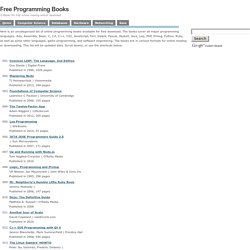
Free Programming Books
So you want to create WordPress themes huh?
Free Programming Resources
PerlMonks - The Monastery Gates
Perl programming documentation
Greetings and welcome to the first of a many-part tutorial series designed to take you from a “hello world” jabroni to a game programmer with the confidence to tackle any challenge that might be foolish enough to face you. This series will be targeted at people who have a small amount of programming experience (those who understand functions, variables, and objects) and are having a hard time making the leap to something more complex.. As I was in this category not but a few years ago, I vividly remember the difficulties moving from basic comp-sci projects to full games and I hope to make your transition easier than mine. If you don't feel that you belong in this category, despair not! Check out my upcoming “education roadmap” entry for a guide to get you from noobgrammer to programmer. If you find yourself confused by a tutorial or would like me to cover a specific subject, shoot me an email at john.hayden@roarigami.com or leave a comment and I'll be happy to oblige.
From Noobgrammer to Programmer - Part 1 -
Indie-Resource.com
Ruby Programming Language
Ruby Programming Language
Ruby Programming Language
Today I finally got round to trying out something i’d been meaning to look into for nearly a year, and seeing as clojure and editors seems to be a topic again I thought it would help add some diversity. Acme is an editor unlike any other. It was designed by Rob Pike for Plan9 (although it’s available for unix-like systems using Plan9 from User Space). Button 1: Select TextButton 2: Execute CommandButton 3: Search/ acquire text (or load file)Button 1-2 CuttingButton 1-3 PastingButton 1-2,3 Cut+Paste (Copy) My introduction to acme was via Russ Cox’ video, which is a great starting point: You can probably summarise the whole thing by saying that in acme – text is data. Obviously this resonated with the clojure part of my brain. Thanks to nrepl the job is really quite easy. All it does is read clojure code from stdin and send it to nrepl. Take a look at the below screenshot. Here’s a video of me doing it: Clojure in Acme from Matthew Williams on Vimeo. To get this setup yourself: That’s it.
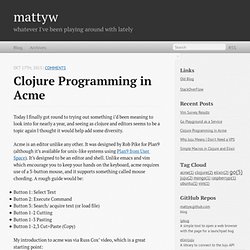
Clojure programming in acme - mattyw
From the three Clojure books I have read so far – Practical Clojure, The Joy of Clojure, and this one – I found Clojure Programming to be the best. I especially liked that the book not only covers the theory but also has an entire part dedicated to practical matters like working with relational databases or using Clojure for web development. This is something I missed from the other two books. Preface Clojure is a dynamically and strongly typed programming language hosted on the Java Virtual Machine (JVM). Down the Rabbit Hole Clojure code can use any Java library, Clojure libraries can in turn be used from Java, and Clojure applications can be packaged just like any Java application and deployed anywhere other Java applications can be deployed. Clojure is part of the Lisp family. All Clojure code is made up of expressions, each of which evaluates to a single value. (def person {:firstname "Daniel" :lastname "Hofstetter"})(:lastname person);= "Hofstetter" There are three comment types:
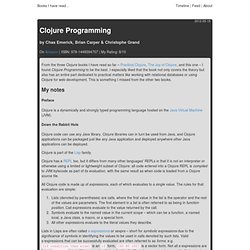
Clojure Programming - by Chas Emerick, Brian Carper & Christophe Grand
Kevin's Programming Reading List
PROGRAMMING
Ask any student who has had some programming experience the following question: You are given a problem for which you have to build a software system that most students feel will be approximately 10,000 lines of (say C or Java) code. If you are working full time on it, how long will it take you to build this system? The answer of students is generally 1 to 3 months. Now let us take an alternative scenario—we act as clients and pose the same problem to a company that is in the business of developing software for clients. Why this difference in productivity in the two scenarios? The answer, of course, is that two different things are being built in the two scenarios. not to be used, nothing of significance depends on the software and the presence of bugs and lack of quality is not a major concern. P. Programming Language Learning Resource Bubbles Edu : Programming | Location : Calgary Publisher : Shaw Website Design Group | Genre : Unix | Date : 2013-12-12 Written by thegoldenpipewrench
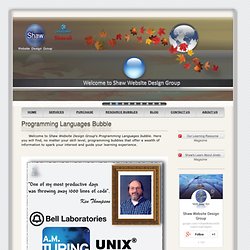
In 1979, C++ was created by Bjarne Stroustrup at Bell Labs in New Jersey. The language was initially called ‘C with Class’ due to its object oriented design. However the name was finally changed in 1983 to C++. C++ foundation encapsulates the entire C language including attributes, features and benefits and also conforms to C’s mantra that the programmer, not the language, is in charge. The following Shaw Website Design - C++ Programming Language Resource bubbles have been gathered from around the web and will be periodically updated. C and C++ Programming Language Bubbles Genre : Programming | Location : Calgary | Date : 2013-12-12 Publisher : Shaw Website Design Group Learn more about C and C++ programming using Resource Bubbles Tags : C++,Cplus,,beginners guide to c, cplus resource, cplus tutorials, learn c++, c programming, c reference,Learning Bubble,Learning Resource,c plus tricks ,cplus learning bubbles;C++ resource bubbles;c programing language resource Written by thegoldenpipewrench
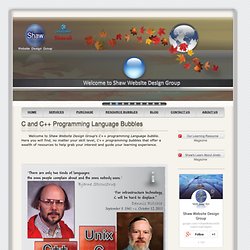
C Programming
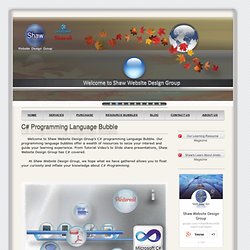 C# was released to the world in 2000 when Microsoft announced the first version of its .NET Framework. Since then C# popularity has become almost viral, and it has arguably become the language of choice for both Web and Windows developers who use the .NET Framework. Part of the attraction of C# comes from its clearly stated syntax, which originates from C/C++. The language is fairly easy to learn and will help a new programmer grasp quickly elementary programming techniques. The following Shaw Website Design - C# Programming Language Resource bubbles have been gathered from around the web and will be periodically updated. C# Programming Resource Bubble Genre : Programming | Location : Calgary | Date : 2013-12-12 Publisher : Shaw Website Design Group Learn more about C Sharp programming using Resource Bubbles Written by thegoldenpipewrench
C# was released to the world in 2000 when Microsoft announced the first version of its .NET Framework. Since then C# popularity has become almost viral, and it has arguably become the language of choice for both Web and Windows developers who use the .NET Framework. Part of the attraction of C# comes from its clearly stated syntax, which originates from C/C++. The language is fairly easy to learn and will help a new programmer grasp quickly elementary programming techniques. The following Shaw Website Design - C# Programming Language Resource bubbles have been gathered from around the web and will be periodically updated. C# Programming Resource Bubble Genre : Programming | Location : Calgary | Date : 2013-12-12 Publisher : Shaw Website Design Group Learn more about C Sharp programming using Resource Bubbles Written by thegoldenpipewrench
C-Sharp-Programming
Programming concepts - /g/wiki
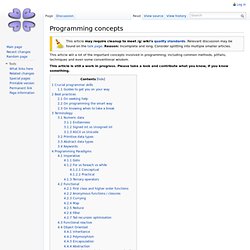 This article may require cleanup to meet /g/ wiki's quality standards. Relevant discussion may be found on the talk page. Reason: Incomplete and long. Consider splitting into multiple smaller articles. This article will a lot of the important concepts involved in programming, including common methods, pitfalls, techniques and even some conventional wisdom. This article is still a work in progress. Crucial programmer skills There are some skills that are considered vital to being a valuable programmer, and that if you wish to be one, you should definitely get to grips with. Version control systems: Git (recommended, especially for open source stuff) and/or Mercurial Repositories Gitorious GitHub BitBucket Document typesetting/preparation LaTeX typesetting system Markdown Console text editors Vim and/or Emacs Command line skill GNU/Linux/Unix shell (read the [man pages]) Windows cmd regular expressions Compiler use GNU Compiler Collection (gcc) Debuggers gdb, valgrind Goto
This article may require cleanup to meet /g/ wiki's quality standards. Relevant discussion may be found on the talk page. Reason: Incomplete and long. Consider splitting into multiple smaller articles. This article will a lot of the important concepts involved in programming, including common methods, pitfalls, techniques and even some conventional wisdom. This article is still a work in progress. Crucial programmer skills There are some skills that are considered vital to being a valuable programmer, and that if you wish to be one, you should definitely get to grips with. Version control systems: Git (recommended, especially for open source stuff) and/or Mercurial Repositories Gitorious GitHub BitBucket Document typesetting/preparation LaTeX typesetting system Markdown Console text editors Vim and/or Emacs Command line skill GNU/Linux/Unix shell (read the [man pages]) Windows cmd regular expressions Compiler use GNU Compiler Collection (gcc) Debuggers gdb, valgrind Goto
UsefulModules
The intent of this page is to list some of the most commonly used Python modules, in the hope that it will provide useful recommendations for other programmers (especially beginners). Remember that in addition to the listings below, there are other directories of Python modules - see PublishingPythonModules for details. Another collection of library details can be found on the Libraries page. Be warned that this list is subjective by its very nature - it is only intended as a helpful guide. Standard Library Backports StandardLibraryBackports - modules that make later standard library functionality available in earlier version Cryptography Python and Cryptography Database SQLAlchemy or SQLObject - Object oriented access to several different database systems DatabaseInterfaces - Direct Python interfaces to relational and non-relational database backends See also DatabaseProgramming for guidance on choosing a database backend system Foreign Function Interface Game Development Console Audio / Music

Django at a glance
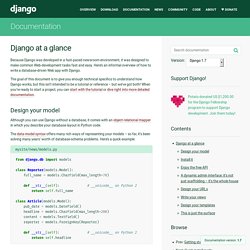 Because Django was developed in a fast-paced newsroom environment, it was designed to make common Web-development tasks fast and easy. Here’s an informal overview of how to write a database-driven Web app with Django. The goal of this document is to give you enough technical specifics to understand how Django works, but this isn’t intended to be a tutorial or reference – but we’ve got both! When you’re ready to start a project, you can start with the tutorial or dive right into more detailed documentation. Design your model¶ Although you can use Django without a database, it comes with an object-relational mapper in which you describe your database layout in Python code. The data-model syntax offers many rich ways of representing your models – so far, it’s been solving many years’ worth of database-schema problems. mysite/news/models.py Install it¶ Next, run the Django command-line utility to create the database tables automatically: $ python manage.py migrate Enjoy the free API¶
Because Django was developed in a fast-paced newsroom environment, it was designed to make common Web-development tasks fast and easy. Here’s an informal overview of how to write a database-driven Web app with Django. The goal of this document is to give you enough technical specifics to understand how Django works, but this isn’t intended to be a tutorial or reference – but we’ve got both! When you’re ready to start a project, you can start with the tutorial or dive right into more detailed documentation. Design your model¶ Although you can use Django without a database, it comes with an object-relational mapper in which you describe your database layout in Python code. The data-model syntax offers many rich ways of representing your models – so far, it’s been solving many years’ worth of database-schema problems. mysite/news/models.py Install it¶ Next, run the Django command-line utility to create the database tables automatically: $ python manage.py migrate Enjoy the free API¶
As the role of the CISO continues to evolve within organizations towards that of an executive level position, we see a growing emphasis on traditional business administration skills over the more technical skills that previously defined the top security leadership job. Nonetheless, CISOs need to keep abreast of the latest down-in-the-weeds tools and technologies that can benefit their organization’s security posture, as well as those tools that are widely available which could be misused by malicious actors to identify and exploit network security weaknesses. In light of that fact, we recently spoke to Nabil Ouchn (@toolswatch), the organizer of the Arsenal Tools exhibit and activities at the BlackHat Conferences in both the US and Europe since 2011, as well as being the founder of the portal ToolsWatch.org. (Part Two Here: Five More Hacker Tools Every CISO Should Understand) Armitage HashCat “There is constantly a battle between security folks and users when it comes to passwords. Wifite
Top Five Hacker Tools Every CISO Should Understand

15 Programming Skills Most Coveted By Employers
More than ever, companies need coders. And while tech firms do the bulk of the hiring, the demand for programmers spans industries and only seems to be growing. From writing basic HTML to building complex logic into mobile applications, the ability to smartly craft lines of code continues to be one of the most in-demand — and often, well-paying — skill sets one can have. (See also: Why This Guy Quit His Sports-Radio Dream Job... So what skills are the most sought after? 15. It may be almost 20 years old, but the object-oriented scripting language is still going strong. Microsoft's server-side Web development framework is more controversial than many of its peers, in part because it's a Microsoft product. AJAX is actually multiple technologies bundled into one. 12. For a 30-year-old programming language, Objective C is looking pretty good. PHP is huge. 10. Python is a general purpose programming language that can be used in a variety of ways. 9. XML is everywhere. 4. 2.
C is one of the most widely used programming languages of all time,[8][9] and C compilers are available for the majority of available computer architectures and operating systems. C is an imperative (procedural) language. It was designed to be compiled using a relatively straightforward compiler, to provide low-level access to memory, to provide language constructs that map efficiently to machine instructions, and to require minimal run-time support. Despite its low-level capabilities, the language was designed to encourage cross-platform programming. The C language also exhibits the following characteristics: The origin of C is closely tied to the development of the Unix operating system, originally implemented in assembly language on a PDP-7 by Ritchie and Thompson, incorporating several ideas from colleagues. The cover of the book, The C Programming Language K&R introduced several language features: For example:
C (programming language)
This is an introduction to concurrent programming with examples in Go . The text covers concurrent threads of execution (goroutines), basic synchronization techniques (channels and locks), basic concurrency patterns in Go, deadlock and data races, parallel computation. Before you start, you need to know how to write basic Go programs. 1. Go permits starting a new thread of execution, a goroutine , using the go statement. Goroutines are lightweight, costing little more than the allocation of stack space. The following program will print "Hello from main goroutine" . func main() { go fmt.Println("Hello from another goroutine") fmt.Println("Hello from main goroutine") // At this point the program execution stops and all // active goroutines are killed. } The next program will, most likely, print both "Hello from main goroutine" and "Hello from another goroutine" . Here is a somewhat more realistic example, where we define a function that uses concurrency to postpone an event. 2. Close 3. 4.
Fundamentals of concurrent programming
Computer Programming: How do reference counting and garbage collection compare?
The Infinitely Profitable Program | peetm
The Infinitely Profitable Program Ξ March 11th, 2008 | → 17 Comments | ∇ Coding , Geeky , Software , Technical | A recent article on Slashdot about assembler games-programming on an Atari [ Donkey Kong and Me ] got me reminiscing about writing assembler apps in my own early days – and about the machines we had way back when. Having earlier cut my teeth on a DEC PDP-8, the biggest kick I got was when CP/M came out. CP/M was initially a ‘business operating system’ – but – it was also a system that one could possibly afford to have at home, on a P ersonal C omputer – serious stuff for an up-and-coming nerd! I was working for Tatung at the time, and as they built computers, I got to play with some pretty expensive kit – twin five and a quarter inch floppy drives and everything ! Peet’s Utilities: I wrote articles for Tatung’s Einstein magazine, which I still have kicking around somewhere, and some commercial programs too. The left most machines in the picture are Tatung Einsteins. Bytes 0
unnamed pearl
Network Programming with Go
Power Programming with Mathematica
Multithreaded Programming Guide
POSIX Threads Programming
C/C++ macros programming - CodeProject


 Free Programming Books
Free Programming Books
 Clojure programming in acme - mattyw
Clojure programming in acme - mattyw
 Clojure Programming - by Chas Emerick, Brian Carper & Christophe Grand
Clojure Programming - by Chas Emerick, Brian Carper & Christophe Grand

 C Programming
C Programming
 C# was released to the world in 2000 when Microsoft announced the first version of its .NET Framework. Since then C# popularity has become almost viral, and it has arguably become the language of choice for both Web and Windows developers who use the .NET Framework. Part of the attraction of C# comes from its clearly stated syntax, which originates from C/C++. The language is fairly easy to learn and will help a new programmer grasp quickly elementary programming techniques. The following Shaw Website Design - C# Programming Language Resource bubbles have been gathered from around the web and will be periodically updated. C# Programming Resource Bubble Genre : Programming | Location : Calgary | Date : 2013-12-12 Publisher : Shaw Website Design Group Learn more about C Sharp programming using Resource Bubbles Written by thegoldenpipewrench
C-Sharp-Programming
C# was released to the world in 2000 when Microsoft announced the first version of its .NET Framework. Since then C# popularity has become almost viral, and it has arguably become the language of choice for both Web and Windows developers who use the .NET Framework. Part of the attraction of C# comes from its clearly stated syntax, which originates from C/C++. The language is fairly easy to learn and will help a new programmer grasp quickly elementary programming techniques. The following Shaw Website Design - C# Programming Language Resource bubbles have been gathered from around the web and will be periodically updated. C# Programming Resource Bubble Genre : Programming | Location : Calgary | Date : 2013-12-12 Publisher : Shaw Website Design Group Learn more about C Sharp programming using Resource Bubbles Written by thegoldenpipewrench
C-Sharp-Programming
 This article may require cleanup to meet /g/ wiki's quality standards. Relevant discussion may be found on the talk page. Reason: Incomplete and long. Consider splitting into multiple smaller articles. This article will a lot of the important concepts involved in programming, including common methods, pitfalls, techniques and even some conventional wisdom. This article is still a work in progress. Crucial programmer skills There are some skills that are considered vital to being a valuable programmer, and that if you wish to be one, you should definitely get to grips with. Version control systems: Git (recommended, especially for open source stuff) and/or Mercurial Repositories Gitorious GitHub BitBucket Document typesetting/preparation LaTeX typesetting system Markdown Console text editors Vim and/or Emacs Command line skill GNU/Linux/Unix shell (read the [man pages]) Windows cmd regular expressions Compiler use GNU Compiler Collection (gcc) Debuggers gdb, valgrind Goto
This article may require cleanup to meet /g/ wiki's quality standards. Relevant discussion may be found on the talk page. Reason: Incomplete and long. Consider splitting into multiple smaller articles. This article will a lot of the important concepts involved in programming, including common methods, pitfalls, techniques and even some conventional wisdom. This article is still a work in progress. Crucial programmer skills There are some skills that are considered vital to being a valuable programmer, and that if you wish to be one, you should definitely get to grips with. Version control systems: Git (recommended, especially for open source stuff) and/or Mercurial Repositories Gitorious GitHub BitBucket Document typesetting/preparation LaTeX typesetting system Markdown Console text editors Vim and/or Emacs Command line skill GNU/Linux/Unix shell (read the [man pages]) Windows cmd regular expressions Compiler use GNU Compiler Collection (gcc) Debuggers gdb, valgrind Goto

 Because Django was developed in a fast-paced newsroom environment, it was designed to make common Web-development tasks fast and easy. Here’s an informal overview of how to write a database-driven Web app with Django. The goal of this document is to give you enough technical specifics to understand how Django works, but this isn’t intended to be a tutorial or reference – but we’ve got both! When you’re ready to start a project, you can start with the tutorial or dive right into more detailed documentation. Design your model¶ Although you can use Django without a database, it comes with an object-relational mapper in which you describe your database layout in Python code. The data-model syntax offers many rich ways of representing your models – so far, it’s been solving many years’ worth of database-schema problems. mysite/news/models.py Install it¶ Next, run the Django command-line utility to create the database tables automatically: $ python manage.py migrate Enjoy the free API¶
Because Django was developed in a fast-paced newsroom environment, it was designed to make common Web-development tasks fast and easy. Here’s an informal overview of how to write a database-driven Web app with Django. The goal of this document is to give you enough technical specifics to understand how Django works, but this isn’t intended to be a tutorial or reference – but we’ve got both! When you’re ready to start a project, you can start with the tutorial or dive right into more detailed documentation. Design your model¶ Although you can use Django without a database, it comes with an object-relational mapper in which you describe your database layout in Python code. The data-model syntax offers many rich ways of representing your models – so far, it’s been solving many years’ worth of database-schema problems. mysite/news/models.py Install it¶ Next, run the Django command-line utility to create the database tables automatically: $ python manage.py migrate Enjoy the free API¶
